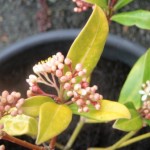Skimmia – Mystery (partially) solved
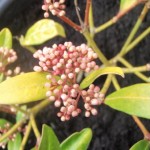 My post last week got me thinking about the mystery plant I had been neglecting. I have had the plant since 2008 and had just hoped it would perk up over time. Every year I topped it up with Sea Soil and assumed nutrients would filter down to the roots. A couple of years ago I repotted it, thinking it was outgrowing its pot, but the root ball was very small and compacted. And every year it has sickly yellow leaves. It always develops pink buds through the winter and flowers in March to April, but has not grown much since I first got it. So this year I will put in some effort to see if I can cure its sad look.
My post last week got me thinking about the mystery plant I had been neglecting. I have had the plant since 2008 and had just hoped it would perk up over time. Every year I topped it up with Sea Soil and assumed nutrients would filter down to the roots. A couple of years ago I repotted it, thinking it was outgrowing its pot, but the root ball was very small and compacted. And every year it has sickly yellow leaves. It always develops pink buds through the winter and flowers in March to April, but has not grown much since I first got it. So this year I will put in some effort to see if I can cure its sad look.
The first step was to figure out what the heck it is called so I can learn more about it! A quick internet search of ‘shade tolerant shrub’ turned up some nursery webpages that had lots of pictures I could scroll through. It is some type of Skimmia. Though I don’t know the variety, Skimmia japonica seems pretty common.
I searched the UBC Botanical Garden Forum for Skimmia posts, keeping an eye out for threads about sickly or unhealthy plants. They like acidic soil (check, since our rain is naturally quite acidic), but if it is too much below 6.0 pH, the soil should be ‘sweetened’ a bit with garden lime. They also are sometimes prone to spider mites, so I’ll have to keep an eye out for that. They do like shade (check) as their leaves can get burned in the summer. As well, well-draining soil is important as it can get root rot. Also, they are dioecious plants, which means they require a male and female plant in order for berries to set. However, I don’t know if I have a male or female.
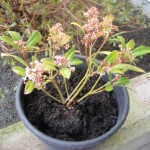 Armed with this new knowledge, I turned a new leaf (haha…) and began caring for my Skimmia by amending its soil last Saturday.
Armed with this new knowledge, I turned a new leaf (haha…) and began caring for my Skimmia by amending its soil last Saturday.
This is the ‘before’ picture. As you can see it is very sparse, and leaves are yellowy green.
 In a wide circle around the base of the plant, I dug in to pull it up with (hopefully) minimal disturbance of its root ball. It doesn’t look like there has been much root growth in the past two years. I loosened the soil remaining in the pot and amended it with bone meal, dry fish fertilizer, and large sand/fine gravel.
In a wide circle around the base of the plant, I dug in to pull it up with (hopefully) minimal disturbance of its root ball. It doesn’t look like there has been much root growth in the past two years. I loosened the soil remaining in the pot and amended it with bone meal, dry fish fertilizer, and large sand/fine gravel.
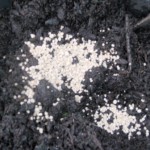 Bone meal (white stuff) provides an organic source of phosphorus and promotes root growth. Ideally, you should always add some bone meal when transplanting, so that was a mistake I made when I first potted up. If you have bulbs, it is also helpful to spread bone meal annually.
Bone meal (white stuff) provides an organic source of phosphorus and promotes root growth. Ideally, you should always add some bone meal when transplanting, so that was a mistake I made when I first potted up. If you have bulbs, it is also helpful to spread bone meal annually.
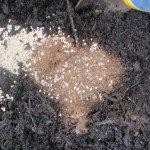 Dry fish fertilizer (brownish mixture) is organic and provides a balance of nutrients. I added this because I did not change out the soil that was in the pot already. I’m currently using a brand called Organika, but have used Gaia Green in the past. In any case, I rely on natural rather than chemical fertilizers.
Dry fish fertilizer (brownish mixture) is organic and provides a balance of nutrients. I added this because I did not change out the soil that was in the pot already. I’m currently using a brand called Organika, but have used Gaia Green in the past. In any case, I rely on natural rather than chemical fertilizers.
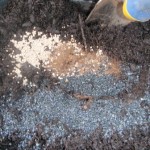 Sand and/or small gravel help to improve soil drainage. In my case, I had a bag of decorative garden sand (shiny black stuff), so I mixed this in. Poor drainage could be the reason for the yellow leaves, as it rains most days through the winter.
Sand and/or small gravel help to improve soil drainage. In my case, I had a bag of decorative garden sand (shiny black stuff), so I mixed this in. Poor drainage could be the reason for the yellow leaves, as it rains most days through the winter.
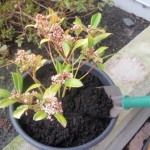 All amendments were mixed thoroughly and then I replanted the Skimmia. I topped up the pot with new Sea Soil. Usually when you do this, you will want to water the plant well. However, it has been raining all week and the soil was already pretty wet, and it is expected to rain again today, so I passed on the watering.
All amendments were mixed thoroughly and then I replanted the Skimmia. I topped up the pot with new Sea Soil. Usually when you do this, you will want to water the plant well. However, it has been raining all week and the soil was already pretty wet, and it is expected to rain again today, so I passed on the watering.
Although I have figured out what this plant is, I still don’t know why it is so unhappy. So I’ll keep an eye on it through the summer and see how it does. Since it is not good for me to dig it up every year to check out the root growth, I’ll pay particular attention to its leaves.
